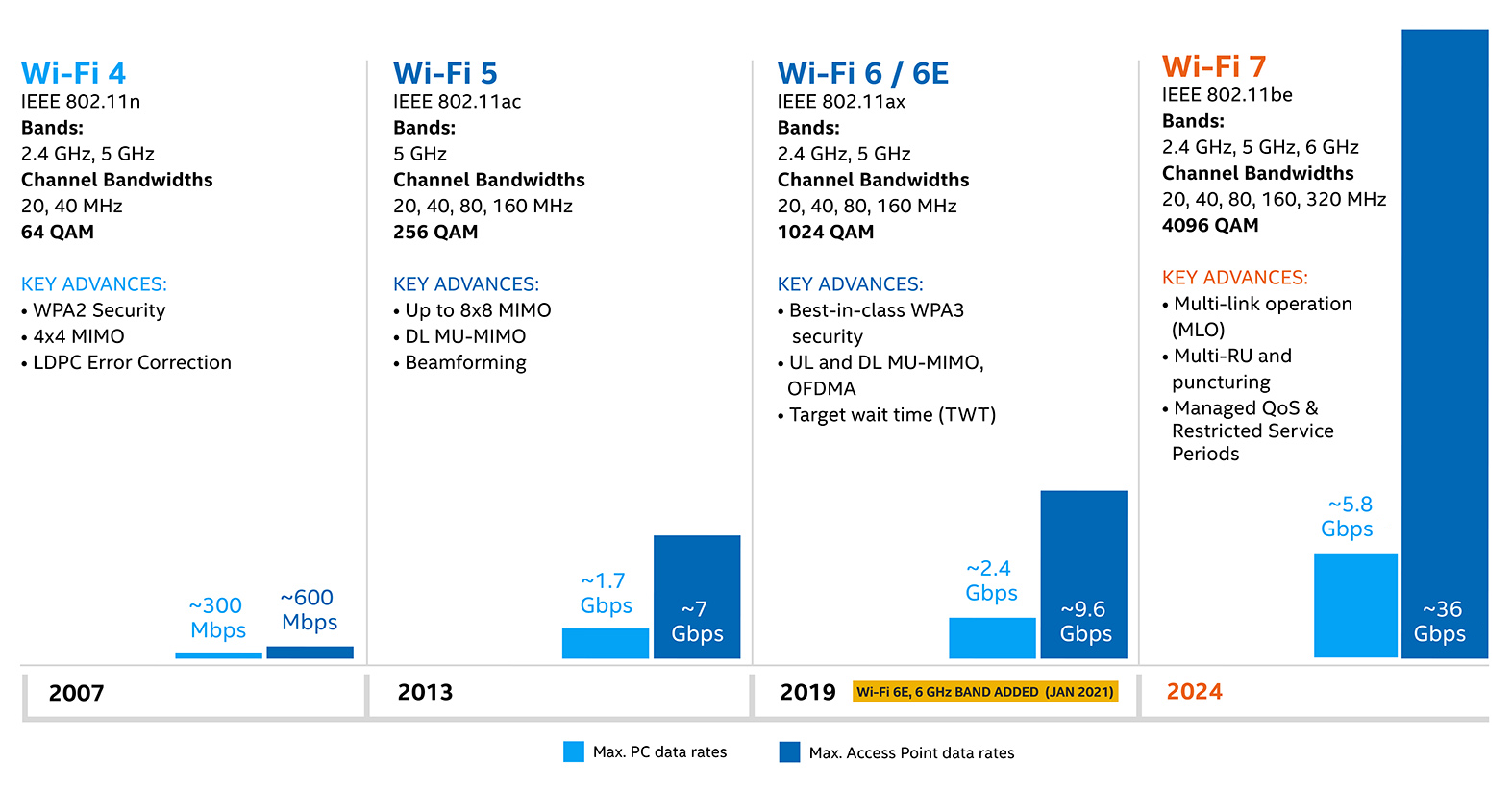Wi-Fi-7 Technology
Experience a quantum leap in wireless performance from 8K streaming video to immersive VR experiences, users around the world can enjoy all-new levels of increased speed and reduced latency compared to previous wireless generation products.

What is Wi-Fi 7?
Wi-Fi 7 is the next-generation wireless networking technology that offers faster network speeds, enhanced security, and increased capacity for simultaneous connections. Also, known as 802.11be, or IEEE 802.11be, it’s the latest update to the wireless networking standard, designed to offer faster and more reliable connections for all device types, including smartphones, laptops, and IoT devices.
According to various calculations, Wi-Fi 7 offers a theoretical maximum data rate of 40+ Gbps. That’s more than four times faster than the theoretical 9.6 Gbps offered by Wi-Fi 6. Wi-Fi 7 builds upon the features introduced in Wi-Fi 6 and 6E, like OFDMA, dual directional MU-MIMO (Multi-user multi-input multi-output), and the 6 GHz wireless band to deliver enhanced network capacity, higher maximum speeds, and better overall performance.
Overall, Wi-Fi 7 is set to revolutionize the way we connect to the internet and access online services.
Leading the Way in Wi-Fi
Wi-Fi has helped keep the world informed, entertained, and productive. This was made possible through IEEE (Institute of Electrical and Electronics Engineers) industry standards and the extensive device interoperability and certification testing of the WFA (Wi-Fi Alliance). Intel is proud to lead in both groups, driving the continuous evolution of Wi-Fi—including its next generation, Wi-Fi 7, based on features defined in the IEEE P802.11be draft amendment.
Transforming the User Experience
Wi-Fi 7 features will build upon, and elevate, earlier Wi-Fi generations. This will mean not only faster speeds, but dramatically improved responsiveness and reliability for immersive consumer experiences and sophisticated future technologies.
Wi-Fi 7 - The Next Evolution of Wi-Fi
Accelerated Connectivity
Greater than 5 Gbps PC Wi-Fi speeds with consistent ultra-low latency - share files in seconds vs minutes.
Rock-Solid Reliability
Peace of mind your PC will make and maintain the best Wi-Fi connections simultaneously.
Wired-Like Responsiveness
No-compromise gaming throughout the home.
Enhanced Privacy and Security
Trust in your connectivity.
Key Features of Wi-Fi 7
The Wi-Fi Standards Evolution
The new generation of Wi-Fi will bring a wealth of improvements for all-new levels of responsiveness and consistency.
For more than 20 years, Wi-Fi technology has helped keep the world connected by meeting the growing needs of a constantly expanding user base. Along the way, Intel has been part of this evolving effort.
Wi-Fi 7 features will expand upon the innovation of Wi-Fi 6 and Wi-Fi 6E to not only enable faster speeds, but dramatically improve responsiveness and reliability for future usages that demand extreme consistency and precision.

320 MHz Channels & 4K QAM
Wi-Fi 7 enables significantly faster speeds by packing more data into each transmission. 320 MHz channels are twice the size of previous Wi-Fi generations—which is somewhat like using a semi-truck to move boxes, compared to a moving van.
4K QAM (Quadrature Amplitude Modulation) enables each signal to more densely embed greater amounts of data compared to the 1K QAM with Wi-Fi 6/6E, which – to continue the truck analogy-- is like having professional movers optimize truck cargo space to pack the maximum number of boxes.
The benefit for a typical Wi-Fi 7 laptop is a potential maximum data rate of almost 5.8 Gbps. This is 2.4X faster than the 2.4 Gbps possible with Wi-Fi 6/6E and could easily enable high quality 8K video streaming or reduce a massive 15 GB file download to roughly 25 seconds vs. the one minute it would take with the best legacy Wi-Fi technology.

More densely packed cargo
When combined with new 320 MHz channel bandwidths, 4K QAM delivers 2.4X faster speeds than Wi-Fi 6, with PC users experiencing maximum speeds over 5 Gbps.

MLO & Deterministic Latency
While legacy Wi-Fi provides access to multiple wireless bands, devices typically choose only one band to make transmissions—switching to another if conditions change. With MLO (Multi-Link Operation), Wi-Fi 7 devices can simultaneously connect on two bands. This enables faster speeds through aggregation. Or, both bands can be used concurrently to share redundant/unique data for improved reliability with ultra-low and precise latencies.
To return to the truck analogy: Think of the legacy Wi-Fi device as moving vans that can only take one highway at a time and choose alternate routes if they run into traffic. However, Wi-Fi 7 semi-trucks will simultaneously operate across two highways to get more boxes to the destination more quickly.
Alternatively, identical boxes can be loaded onto trucks on both highways to help ensure at least one of each type arrives at the destination. Lastly, the most important boxes can be loaded onto the truck taking the fastest route—ensuring that the arrival of critical belongings is not impacted by potential delays.

Multi Resource Units (RU) and Puncturing
With legacy Wi-Fi 6/6E, when any part of a large high-speed channel is being used by another device, the entire channel is unavailable—and a different channel must be used. This is like the legacy Wi-Fi moving van not being able to access a particular multi-lane highway and having to find an alternate route because passenger cars are using one of the lanes.
With Multi-RU Puncturing, Wi-Fi 7 devices will be able to use other parts of the same high-speed channel not in use to enable very large channels (even if they are less than the maximum 320 MHz size.) This would be like the Wi-Fi 7 movers being able to re-pack most of the semi-truck contents into smaller trucks without having to avoid a partially used multi-lane highway so they can deliver boxes to the destination more quickly and reliability.

Compare Wi-Fi Generations
See how Wi-Fi 7 stacks up to earlier Wi-Fi generations.
| Wi-Fi 5 (802.11ac) | Wi-Fi 6 (802.11ax) | Wi-Fi 6E (802.11ax) | Wi-Fi 7 (802.11be) | |
|---|---|---|---|---|
| Frequency | 5 GHz | Dual-Band (2.4 & 5 GHz) | Tri-Band (2.4, 5, & 6 GHz) | Tri-Band (2.4, 5, & 6 GHz) |
| Bandwidth (Channel Sizes) | 20, 40, 80, 160 MHz 80+80 MHz |
20, 40, 80, 160 MHz 80+80 MHz |
20, 40, 80, 160 MHz 80+80 MHz |
20, 40, 80, 160, 320 MHz 80+80, 160+160 MHz |
| Access (Multiplexing) | Orthogonal Frequency-Division Modulation (OFDM) | Orthogonal Frequency-Division Multiple Access (OFDMA) | Orthogonal Frequency-Division Multiple Access (OFDMA) | Orthogonal Frequency-Division Multiple Access (OFDMA) |
| Modulation | 256 QAM | 1024 (1K) QAM | 1024 (1K) QAM | 1024 (1K) QAM |
| Antenna | DL MU-MIMO (4x4) | DL + UL MU-MIMO (8x8) | DL + UL MU-MIMO (8x8) | DL + UL MU-MIMO (8x8) |
| Security | WPA2 | WPA2/3 | WPA3 | WPA3 (Enhanced) |
| Key Innovations | 80 MHz Mandatory Beamforming | Target Wake Time (TWT), BSS Coloring 6 GHz Operation (Wi-Fi 6E) |
Target Wake Time (TWT), BSS Coloring 6 GHz Operation (Wi-Fi 6E) |
Multi-Link Operation (MLO), Enhanced Multi-Link Single Radio (eMLSR), Multi-Resource Unit (RU), Improved QoS Framework |

